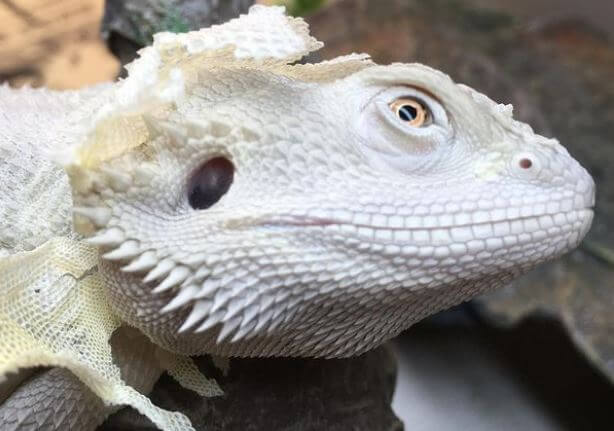So, what does it mean when a bearded dragon turned white and died?
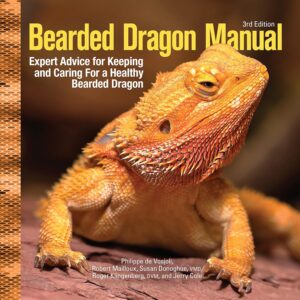 Lizards turn white sometimes, which is normal for some reasons. But what if one day you wake up and see your bearded dragon turned white and died suddenly?
Lizards turn white sometimes, which is normal for some reasons. But what if one day you wake up and see your bearded dragon turned white and died suddenly?
How do you say if your buddy is facing some unfortunate illness or doing well?
In this article, we will discuss further this topic.
You will understand why the reptile turns weird colors, what it means, and how to respond to that symptom.
Related Posts:
- How Big Can a Bearded Dragon Get?
- Why Is My Beardie Hissing at Me?
- Bearded Dragon Brumation or Dead: How to Differentiate?
- How to Pick Up a Bearded Dragon?
- Why Is My Beardie Breathing Heavy?
- Bearded Dragon Fat Belly: What Should You Do?
- Can Beardies Get High?
Why Do Bearded Dragons Turn White?
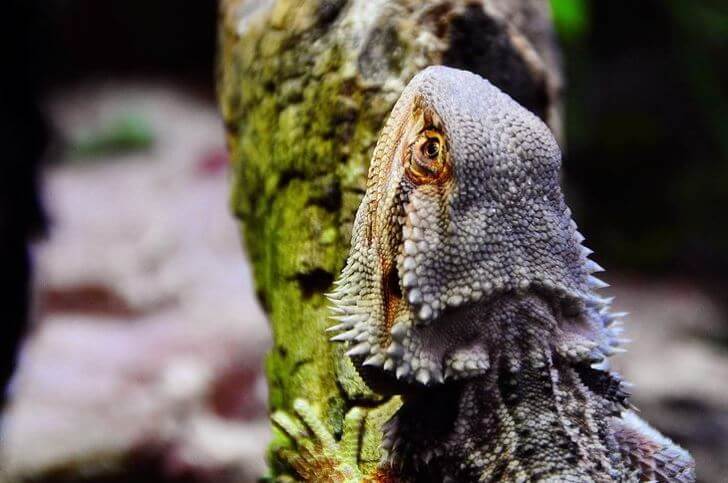
Bearded dragons express changes in emotions, well-being, and feelings through different behaviors.
Some of those habits include changes in body color, black beard, arm waves, bobbing heads, etc.
Bearded dragons can make their body or some parts, and even their tail, head, mouth, and nose, turn white for some reason.
However, they are not always bad signs.
1. He Is Preparing to Shed
The most common cause bearded dragons turn white is due to shedding.
Shedding is a natural phase, and it happens most frequently in baby dragons when they grow immensely. As the beardies become older, they shed less, normally only several times a year.
So, the top skin will turn blue or white, and it can happen in patches on the skin of the dragon.
You do not have to worry about that since this process can take between two and three weeks to complete.
Ensure that the moisture in the box is 30 to 40% and mist him once a day to make the shedding process quicker and easier.
In case of remaining old skin, bathe the pet in warm water to smooth the skin, but do not remove it with your hands.
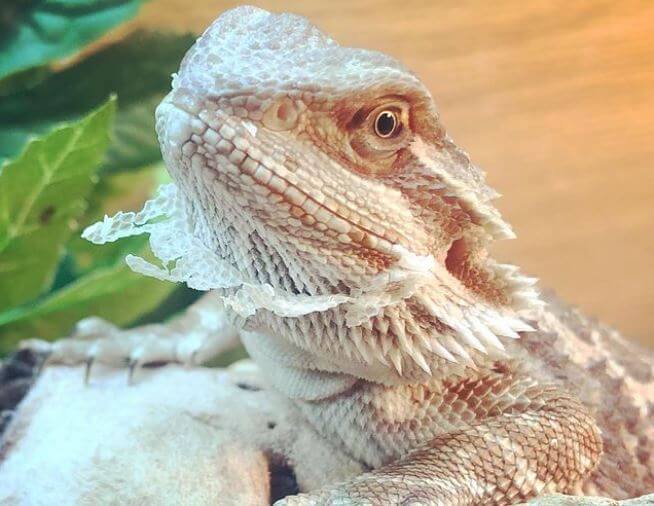
2. The Temperature Is Unstable
When a beardie gets cold, it gets darker. On the other hand, as it gets hotter, he absorbs less heat and can turn white.
The beardies need warmth to digest and live. The temperature range depends on their age.
Therefore, you need to check the temperature both in the tank and basking spots frequently, so he can grow healthily.
For baby bearded dragons, the basking spot must be around 110°F. For adults, it is about 100 to 105°F.
Watch this video to learn more about bearded dragon lighting and temperature.
3. He Is Sleeping
While sleeping, bearded dragons will turn white, and this is very common. Research reveals that it is caused by their circadian cycle.
So, it is not necessarily a huge worry for bearded dragons to turn white at night.
But if they don’t get back to a normal tone after waking up, it can reveal something strange. Get advice from reptile experts or a vet.
What Does It Mean When a Bearded Dragon Turns White and Avoids Eating?
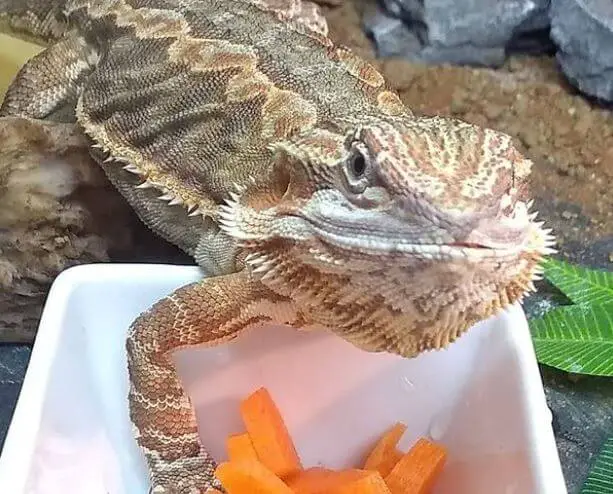
Turning white doesn’t always indicate a serious health issue for reptiles. But if they refuse to eat and they look sluggish, this could be a sign that your animal may die.
You can look at the specific parts of their body to know if they are about to die. If the tail, arms, and face are pale, that is a sign of a dying bearded dragon.
A dragon may hit a stage when they are old and nasty.
Make sure that you check the impaction for a sudden change of color and usual behavior. Impaction may be caused by his ingestion of insect feeds, large items, or indigestible chitin.
I did not know about this impaction until my bearded dragon turned white and died.
We recommend taking full blood tests to understand what is going wrong with your lizard.
1. Internal Organ Issues
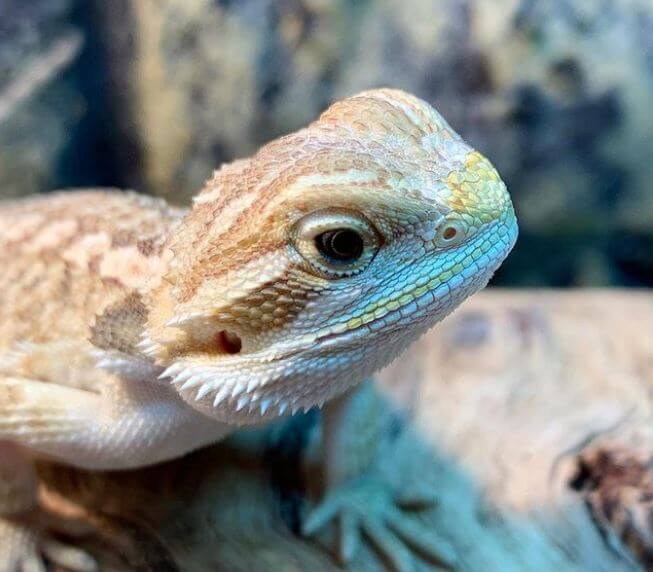
Most common issues happen in the kidneys or liver.
Take the pet to the vet to have a full blood test. It will show all the enzyme levels that indicate if they have any issues or not.
The amounts of uric acid, urea nitrogen levels, and muscle wastes can all show in kidney function.
In the case of high levels, it can cause some serious illnesses like gout, dehydration, or liver damage.
2. Metabolic Bone Disease

The lack of calcium also leads to suffering from metabolic bone disease. Try the Zoo Med calcium with vitamin D3 as a complementary supplement.
What Are the Signs a Bearded Dragon Is Dying?
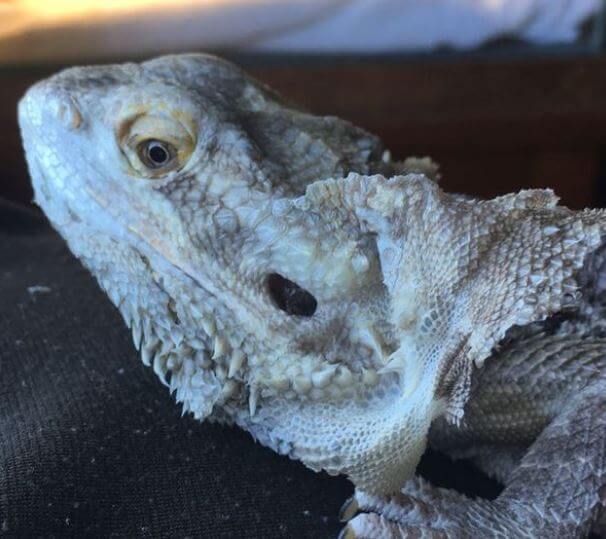
Except for turning white and acting strangely, there are some additional symptoms of a dying lizard you should pay attention to:
- Lethargy – Bad heating lethargy is a serious concern to look into.
- Cloudy Eyes – A healthy dragon has bright eyes. Their eyes can look gray or blurry during shedding, but something is wrong with their health if this symptom lasts longer than the shedding period.
- Soft, Smelly, and Watery Poop – This happens when your pet is dealing with internal parasites or digestion illness.
- Swollen Tail – Maybe the arm or tail is broken.
- Loss of Appetite – This can be due to several reasons. Stress and wrong-size cages can also lead to appetite loss.
- Air Gasping – This is one symptom of metabolic bone disease. They would also have a slack jaw if they leave their mouth continuously open and have trouble with food.
- Bloody or Broken Snout – If your pet has any of those symptoms, bring them to the nearest vet to have emergency aid.
Or you can try to save your bearded dragon at home if you can!
Related Posts:
- Can Beardies Eat Peas?
- Can Beardies Eat Rosemary?
- Do Beardies or Dogs Eat Pears?
- Can Beardies Eat Squash?
- Can Beardies Eat Brussel Sprouts?
Frequently Asked Questions About Bearded Dragons
1. Why Does My Bearded Dragon Turn Black?
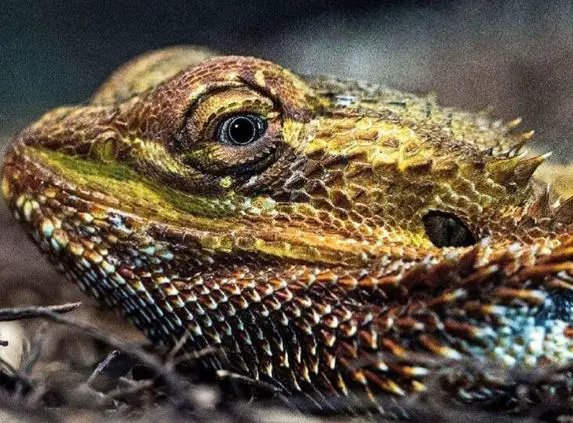
Besides glass surfing, you should take care of them, especially when your pet darkens in color. That is most noticeable on his beard.
If your dragon has a black beard, a change, even if it was assumed to be a positive change, may be because they are stressed.
2. Why Does My Bearded Dragon Have a White Tongue?
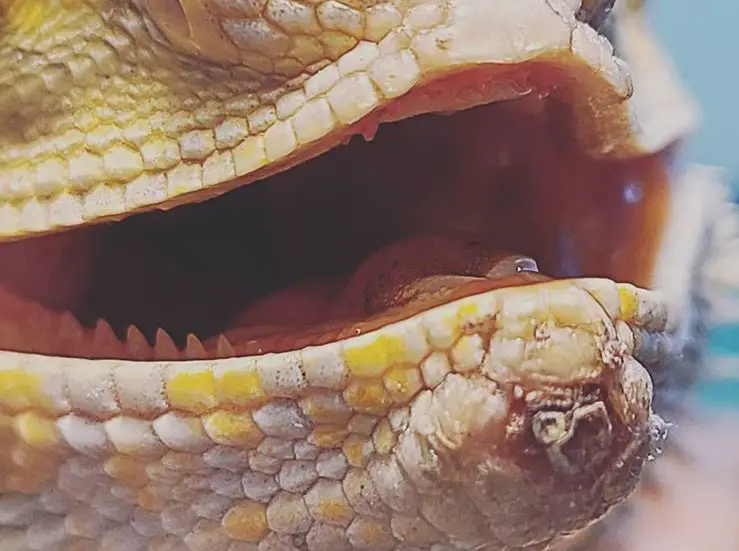
If the bearded dragon’s tip of the tongue is white, it is normal.
Not only are these portions of their tongue lighter, but they also have goose skin and convenient physical modification that makes it simpler and easier for them to push away prey.
3. Why Is My Bearded Dragon’s Poop White?
 For beardies, the most common color of poop is brown and white.
For beardies, the most common color of poop is brown and white.
Brown, long poop with a white part on the end is normal. White is the urate or the pee. Since they don’t pee, urates come out instead.
However, if bearded dragons have runny white poop, they may have some issues with their digestive system.
4. What Are the Signs My Bearded Dragon Has a Parasite?
You can’t detect whether there are parasites inside your pet. It can only be detected by taking a fecal test.
The parasite can, in some cases, lead to diarrhea or loss of weight.
Pinworms are common parasites in the gastrointestinal tracts of your dragon.
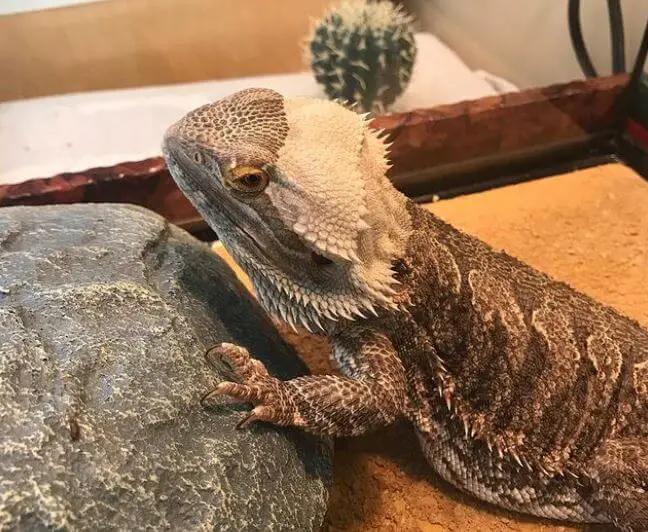
5. What Can I Do If My Bearded Dragon Refuses to Eat?
Take the triple checks to make sure the pet has a stable appropriate temperature and has what they need to survive.
You can keep the tank lights on for at least two hours after the last meal to assist with digestion.
Even in the morning, some picky dragons will not touch the food if they do not get enough heat and light.
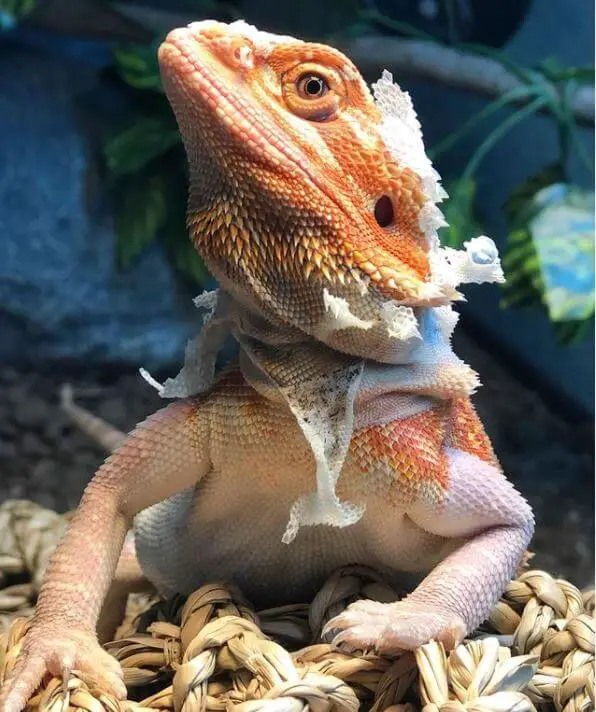
Conclusion
So, what does it mean when a bearded dragon turned white and died?
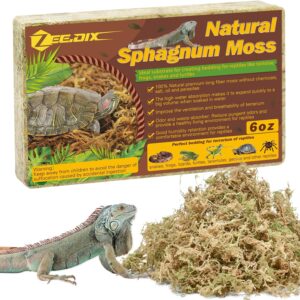 It is most possibly shedding if your bearded dragon suddenly looks white. Even when only one body part (for example, head, arms, nose, mouth, etc.) has gone white, maybe it is shedding, too.
It is most possibly shedding if your bearded dragon suddenly looks white. Even when only one body part (for example, head, arms, nose, mouth, etc.) has gone white, maybe it is shedding, too.
Let your pet shed for a week or two. However, keep checking its condition consistently.
If your bearded dragon looked sick, refused to eat, and was lethargic before they turned white, you should take them to the vet to see if something is wrong before it’s too late.
Moreover, check the temperatures and living conditions in the tank carefully. Because if they are not appropriate, your dragon can also become pale.
Key points for bearded dragon turning white and died:
The sudden change in color and the death of a bearded dragon can be distressing for reptile owners. While various factors can contribute to such occurrences, it’s essential to explore potential causes and consider the following points:
1. Age and Lifespan:
- Bearded dragons have an average lifespan of 8 to 12 years, depending on their care and health. As they age, they may become more susceptible to various health issues.
2. Stress:
- Bearded dragons are sensitive to stress, which can be caused by changes in their environment, handling, or the presence of other pets.
3. Illness or Disease:
- Several health conditions can lead to color changes and ultimately result in a bearded dragon’s death. Common illnesses include metabolic bone disease, respiratory infections, and parasites.
4. Metabolic Bone Disease (MBD):
- MBD can cause bones to weaken and deform, leading to mobility issues and a pale appearance. If left untreated, it can be fatal.
5. Inadequate Husbandry:
- Poor diet, incorrect temperatures, lack of UVB lighting, and improper habitat setup can negatively impact a bearded dragon’s health, potentially leading to death.
6. Respiratory Infections:
- Respiratory issues can cause labored breathing and reduced oxygen intake, leading to lethargy and color changes. These infections can become life-threatening if not treated promptly.
7. Parasites:
- Internal or external parasites, such as mites or worms, can weaken a bearded dragon’s immune system and overall health.
8. Impaction:
- Ingesting substrate, stones, or foreign objects can lead to intestinal blockages and discomfort, ultimately causing severe health issues and potential death.
9. Heat Stress or Overheating:
- Bearded dragons require a basking area with the correct temperature range. Overheating, especially in environments without proper temperature gradients, can lead to heat stress and death.
10. Consult a Veterinarian: – If your bearded dragon is exhibiting unusual behaviors, such as color changes or signs of distress, consult a reptile veterinarian promptly for a diagnosis and treatment.
Preventive Measures:
- Ensure proper husbandry, including a well-balanced diet, appropriate temperatures, UVB lighting, and a clean habitat.
- Regularly observe your bearded dragon for any signs of illness, stress, or discomfort.
- Handle your pet gently and minimize stress-inducing factors in their environment.
- Quarantine new additions to your reptile collection to prevent the spread of diseases or parasites.
- If you suspect an issue with your bearded dragon, seek professional veterinary care promptly.
Bearded dragons can turn white and die for various reasons, including age, stress, illness, or inadequate husbandry. Understanding the potential causes and taking preventive measures, along with timely veterinary care, are essential for maintaining the health and well-being of these beloved reptile companions.
Further Reading:
- Carolina Custom Cages Terrarium Review
- 8 Best Basking Rock for Beardie: What Is the Best Choice?
- 10 Best Thermometers for Beardie: How to Choose the Best One?
- 5 Best Beardie Lighting Setups for Beardie Lovers
- 9 Best Heat Lamps for Beardie: Natural Habitat Provided

